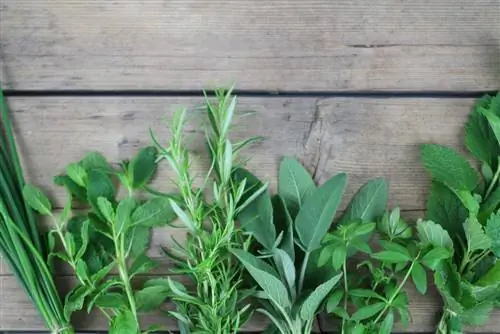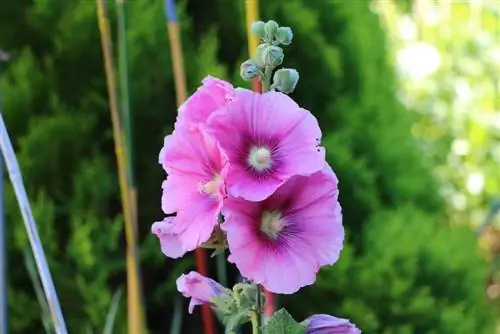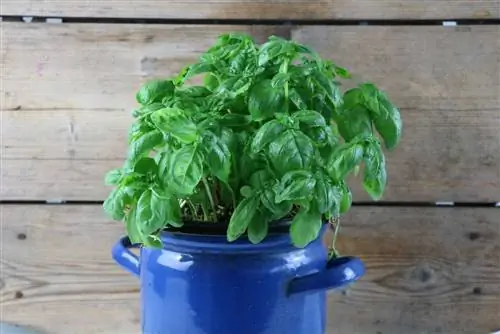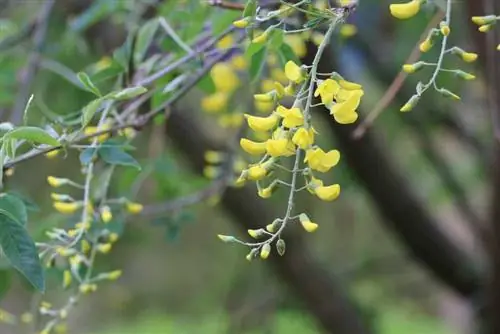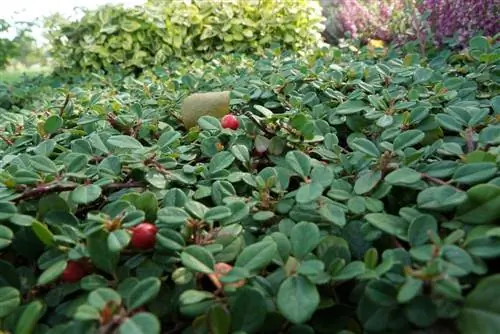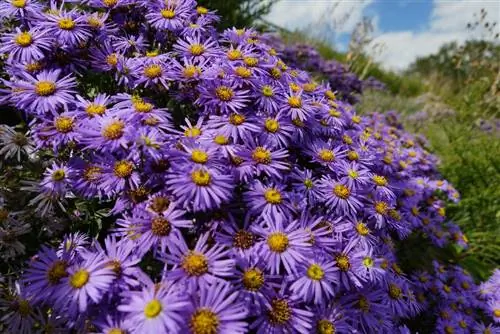- Author admin [email protected].
- Public 2023-12-17 03:39.
- Last modified 2025-01-24 12:45.
Herbs generally need the ideal location. Otherwise their growth and aroma will suffer. As far as soil conditions are concerned, semi-shady and shady herbs prefer moist soils, while herbs for sunny locations prefer dry and barren soils. The nutrient requirements also vary from herb to herb. The less sunlight, the higher the nutrient requirements are usually. However, too much nutrients should be avoided, as this causes stress for these plants and makes them more susceptible to disease.
Herbs for shady locations
Wild garlic
Wild garlic grows perennially, perennially and herbaceously with heights between 20 and 50 cm. Between March and June it exudes an intense garlic aroma. He is very spreading. Its elongated green leaves appear from February and the star-shaped flowers from April/May to June. To prevent unwanted spread, it is recommended to insert a plastic film. All parts of the plant can be used.
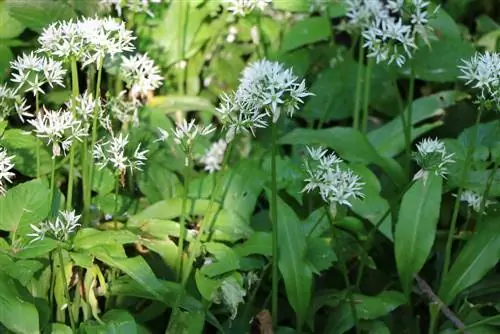
Tip:
Wild garlic is often confused with autumn crocus or lily of the valley, which can be fatal. Wild garlic is the only one of these plants with a garlic scent. Its leaves sit individually on the stem, while those of the autumn crocus have no petiole and grow into several leaves from one stem. The leaves of the lily of the valley always grow in pairs from a stem.
Women's ginseng
Women's ginseng, also known as the 'herb of immortality', is an annual to perennial, herbaceous and fast-growing climbing plant for semi-shady and shady locations. It can climb 400-800 cm high. The white, grape-shaped flowers appear between July and August. Its leaves have a taste similar to licorice and can refine salads, be enjoyed on their own or prepared as tea. Women's ginseng is hardy down to -18 degrees.
Herbs for partially shaded areas
Peppermint
Peppermint grows perennially, herbaceously and heavily branched. It is hardy, produces runners and grows to a height of 25-100 cm. Pruning several times a year controls the spread and promotes growth. Peppermint should be transplanted approximately every 3 years. The fresh or dried leaves and shoots are used.
Tip:
To prevent uncontrolled spread, you can cultivate peppermint in a pot or plant it in the garden together with the pot.
Chives

Chives are one of the classic herbs. It grows perennially and perennially with heights between 10 and 50 cm. The numerous varieties differ in growth and taste. It should be divided in the spring. The tubular leaves are harvested throughout the season. When flowering begins around May, the aroma is no longer as intense.
lovage
Lovage is perennial, herbaceous and hardy. It has a very aromatic scent and can grow up to 250 cm high under optimal conditions. Lovage blooms between July and August and forms so-called double achenes (fruits) after flowering. The plant can be easily propagated by division. The stems and leaves before flowering as well as the seeds and rhizomes are used.
parsley
Parsley is a versatile herb. There are curly and smooth varieties. The leaves of the herbs, which are between 25 and 80 cm high, are similar to those of celery. Parsley can be grown in the garden or in pots and harvested all year round. It has a very spicy taste, although flat-leaf parsley has a more intense aroma. The whole plant including the roots can be used.
Herbs for sunny locations
Basil
Basil needs a warm location. Its numerous cultivated forms differ in leaf color, aroma, growth and location requirements. It is not hardy and is usually cultivated as an annual. This herbaceous, perennial and upright growing herb reaches heights of 20-60 cm. It blooms between June and September. All parts of the plant smell very aromatic. The taste of the leaves is spicy, sweet to slightly peppery. The fresh or dried leaves and stems are used.
Sage
Sage is known primarily as an herb for sore throats but also as a herb. It grows as a perennial, perennial subshrub, sometimes also annual or biennial, with heights of 40-60 cm and flowers from May to July. The leaves are harvested at the beginning of flowering. Sage smells aromatic and has a spicy, bitter taste. The fresh or dried leaves are used.
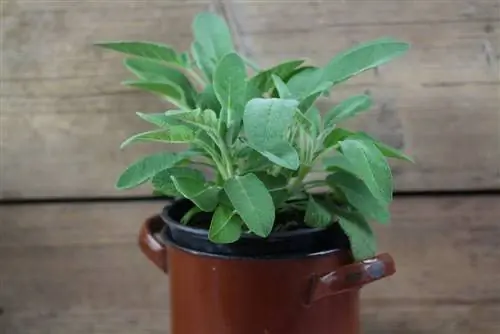
Tip:
Sage in pots often forms horny shoots in winter quarters, which weakens the plant and makes it susceptible to disease. That's why you should put them outside in mild winter periods.
Thyme
Thyme species grow as perennial subshrubs or shrubs. They are woody at the base, grow upright to prostrate and are usually hardy. Depending on the species, it grows between 15 and 40 cm high. Flowering time is between May and October. The small leaves have an intense scent, their taste is slightly tart and very savory. The fruits are egg-shaped nuts containing the seeds. Whole branches are always harvested without cutting into the woody parts of the plant.
Tip:
The sunnier the location, the higher the essential oil content, which intensifies the flavor.
Rosemary
Rosemary is characterized by its needle-like leaves. It grows as a bushy, branched, evergreen subshrub and can reach heights of 200 cm when old. The scent and aroma are very intense. In winter, the above-ground parts of the plant must be protected, for example with fleece. Whole branches are used. Annual pruning keeps the shrub compact.
The ideal soil for herbs
The soil requirements of herbs for semi-shady and shady locations differ significantly from those for sunny locations. Partially shaded herbs require moderately moist soil and regular watering. Shady herbs thrive best in permanently moist, humus-rich soil. A high humus content is particularly important here. Mediterranean herbs prefer dry and barren soils and rarely need to be watered. Regardless of the location, the soil should always be permeable.
Tip:
Soils containing clay and loam in particular should be made more permeable with pumice, quartz sand or similar. Humus-poor soils can be enriched with compost or manure. Sand can deplete soils.
Fertilize herbs properly
Herbs in sunny locations have low nutrient requirements. Basic fertilization with compost is sufficient here. In contrast, semi-shady and shady herbs require significantly more nutrients. This is due, among other things, to the lower light output, which means fewer nutrients can be dissolved in the soil. Accordingly, the latter should be regularly given organic fertilizer such as horn shavings or manure or a slow-release fertilizer.
A fall leaf cover that decomposes over time can provide nutrients for the following year. For herbs in pots, the amount of fertilizer needs to be increased slightly.
Conclusion
Herbs find space in the smallest garden. Location and soil conditions are crucial for an intense aroma and the best seasoning. Herbs not only add spice and flavor to a wide variety of dishes, but can also help against one or two ailments.

